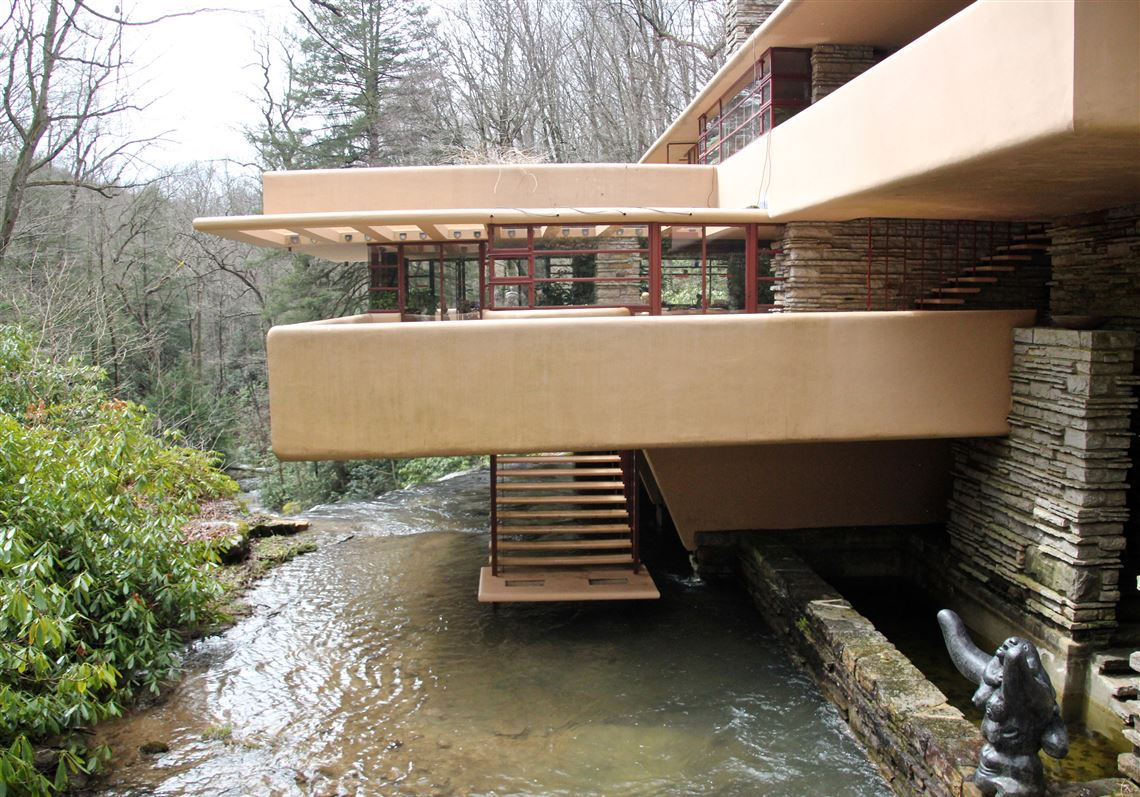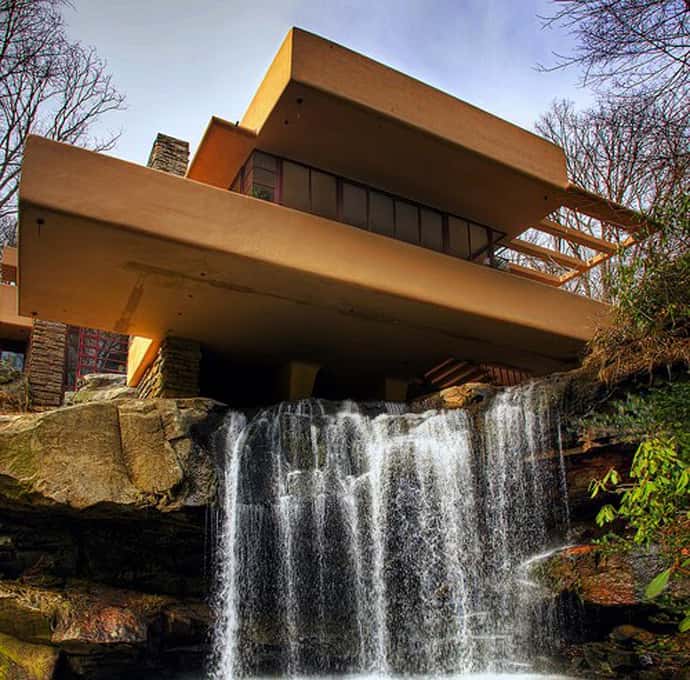Table Of Content

A view of two of Fallingwater's main terraces from the third level of the house. Each of the building's terraces is cantilevered over the stream and waterfall below. The counterbalance was the house's north wall, which kept the building from falling over. Fallingwater underwent major repairs in 2002 to deal with sagging of the terraces and other parts of the building. This is the only kitchen at Fallingwater and was used by the Kaufmann family, as well as the servants and visitors staying in the guest bedrooms or guest house.
Who owns Fallingwater now?
The floors act as tiers/layered, emphasizing the falling of water and integrating the building into the landscape even more. Vined plants were installed above cantilevering rooftops, to further integrate the exterior building with nature. The owners of Fallingwater, are known as Edgar and Liliane Kauffman and were acquaintances of Wright through their son. The Kauffman’s wanted a summer home for their family’s weekend sanctuary in Bear Run, PA.
Fallingwater House – Discover Frank Lloyd Wright’s Architectural Style
The design showcases his appreciation of Japanese culture and art, specifically the works of Katsushika Hokusai, as elements of the drawing break through the borders, a stylistic device often used by Hokusai. Wright was a collector and dealer of Japanese woodblock prints, and his influence can be seen in his design and aesthetics. Frank Lloyd Wright’s connection to Arizona, the location of his personal winter home Taliesin West, runs deep, with his architectural influence seen all over the Valley. Here, PhD student David R. Richardson gives a brief overview of several of Wright’s most notable projects in the Grand Canyon state.
20 Stunning Homes Built Into Nature - Architectural Digest
20 Stunning Homes Built Into Nature.
Posted: Sun, 31 Mar 2024 07:00:00 GMT [source]
Guided Grounds Walking Tour
Because of the cool air coming off the river, opening the hatch let cool air come up into the room, cooling it and much of the rest of the house. This system was an example of Wright's frequent use of organic elements in his architecture. As well, when the hatch was opened, the resulting view of the river brought nature right into the house, another Wright signature.
In-Depth Guided Tour
Natural stone floors continue from the living room well towards the outside terrace. While its form is distinct and standout, Fallingwater was designed for a family to live in and among nature. Fallingwater is a 20th-century masterpiece in organic architecture—one that was created nearly four decades before the design world began to consider its impact on the planet. The habitability of the interior was what truly preoccupied the architect. The interior space had to be light and spacious, and so he set out to avoid limitations as much as possible.
Does anyone live in the Fallingwater house?
On the left is a “wine ball”, a red, spherical container fitted with a handle on a hinge, that allows you to place it over the fire to heat the drink inside. The one on the East side is next to a small exterior staircase which leads to the terrace of the Kaufmann’s son’s bedroom. To the left of the chimney, a door leads to the kitchen; a smaller room than the living room with furniture exclusively designed by Wright for the house, as was the case for the rest of the furniture also. Between the door to the kitchen and the staircase is the dining table, placed against the North wall of the dining room. For the vertical elements of the home—its structural piers and chimney, which also run through the interiors—Wright took inspiration from the specificity of Fallingwater’s isolated Pennsylvania site, as chosen by the nature-loving Kaufmann family. He clad them in local sandstone laid in horizontal striations, like the forms in its natural surroundings.
Available Tours
The building maintains a relationship with the surroundings which comes from a respect for and adaptation to the environment. As such, the foundations of the house are rocks of the place, and some are even found beyond the boundaries of the first floor, leaning next to the chimney. Wright’s engineers were not confident that the structure would support itself and asked Wright to reconsider his plans. His pride allowed him to back down only enough to agree to a number of metallic pieces which supported the cantilever, which remains intact following the effects of a tornado. Two floors of the house extend horizontally with prominent cantilevers and terraces.
In this in-depth guide from AD, rediscover the importance and magic of Wright’s most famous private residence. The construction of the waterfall house, naturally, proved difficult, as there was no solid foundation to build from, only water. Wright overcame this problem by designing “trays”, which were reinforced concrete that mirrored the natural rock of the site. Terraces of local sandstone were cantilevered to blend with the rock formations.
Materials and Tags

Edgar Jr. continued to live there with his partner who was the architect and designer Paul Mayen, who designed the gift store, café, and tourist facility that opened its doors in 1981. Fallingwater, the house designed by American architect Frank Lloyd Wright for Edgar Kaufmann in southwestern Pennsylvania, hangs over a waterfall using the architectural device known as the cantilever. The majority of the house’s structure is made of concrete, with exposed columns and beams forming porticos and the projections (the horizontal elements which extend as terraces over the waterfall) all made of concrete. Some walls and other vertical elements which define the spaces of the house, as well as the floors, were covered in the local stone.
Third, the series represents an architecture conceived to be responsive to the evolving American experience, but which is universal in its appeal. On entering the house by the main entrance, situated at the North face, we arrive at a small room which acts as a reception, located under the stairs which lead to the second floor. Past that room is the living room, the largest public room of the house from which there are splendid views of the woods which surround the house. On entering, we are faced by the “music corner”, whose etymology is unknown, to the right is the sofa area and behind the “music corner” is the “staircase of water”, so called because it leads down to a small platform beside the river.
But it is possible to stay in the four-bedroom mansion, known as the Historic Summit Inn Resort, which was built behind Fallingwater for a whopping $1,200 per night. Because of the cantilevering system that takes up the entirety of what should have been a ground floor, if built on solid ground, the living quarters of the building start on the first floor. Kauffman donated the property in 1963 to the Western Pennsylvania Conservancy, as per his late father’s wishes. The doors were opened as a museum and have been a very popular site to visit for millions of people since. Wright was born in Wisconsin on the 8th of June 1867, although he sometimes claimed that he was born in 1869.
Each level is marked by wide projections which protrude asymmetrically in various directions. In creating this impression, Wright was inspired by Japanese architecture. The exterior of the house maintains an intimate relationship with the surrounding nature. The architect decided to employ natural materials- wood, brick, rock- with which he achieved an impressive integration between the building and the forest which surrounds it.
In 1938, Wright designed additional guest quarters set into the hillside directly above the main house and linked by a covered walkway. In 1963 the Kaufmanns donated the property to the Western Pennsylvania Conservancy, together with 1,543 acres of surrounding land. It opened its door as a museum in 1964 and has since hosted more than five million visitors. Though the late American architect designed more than 1,000 buildings during his career, Frank Lloyd Wright’s Fallingwater—a private home situated over an active waterfall in forested Mill Run, Pennsylvania—is one of his most celebrated. Considered a masterwork of the organic architecture style, Frank Lloyd Wright’s Fallingwater embodies a harmony between site and design that the architect championed. Designed in 1935, the house is defined by a series of stucco-covered concrete cantilevered terraces that are fixed to the natural rock of the fall, and the façade is constructed of local sandstone slabs that create a visual kinship with its environment.
The interior layout focuses of Wright’s signature concept of compression and openness, where small spaces lead to large open plan ones. On the first floor of the Fallingwater house, visitors move through the intimately sized entry to a continuous dining and living room. A hatch in the floor opens to reveal an exterior suspended staircase that leads down to the Bear Run stream. Frank Lloyd Wright was known for designing a residence holistically, including built-in furnishings, lighting fixtures, and millwork, as well as sourcing and arranging furniture for his clients. He executed projects with a vision not only for aesthetic and function, but for family living as defined by the architecture itself. The architect designed almost 170 custom wood furnishings for the house in a style that blended harmoniously with the architecture.
Since Frank Lloyd Wright’s Fallingwater opened to the public in 1964, visitors from around the world have experienced this masterwork. We offer you extensive information about the history of art, analyses of famous artworks, artist biopics, information on architecture, literature, photography, painting, and drawing. No, it is not possible to stay over in the main house, as it is now an official museum.
No comments:
Post a Comment